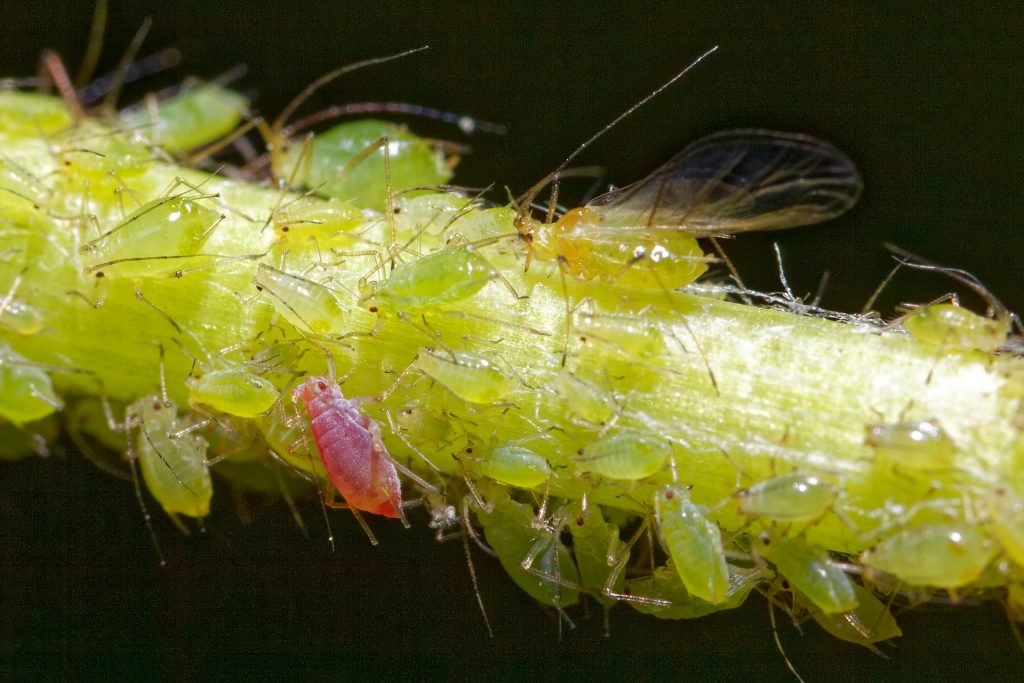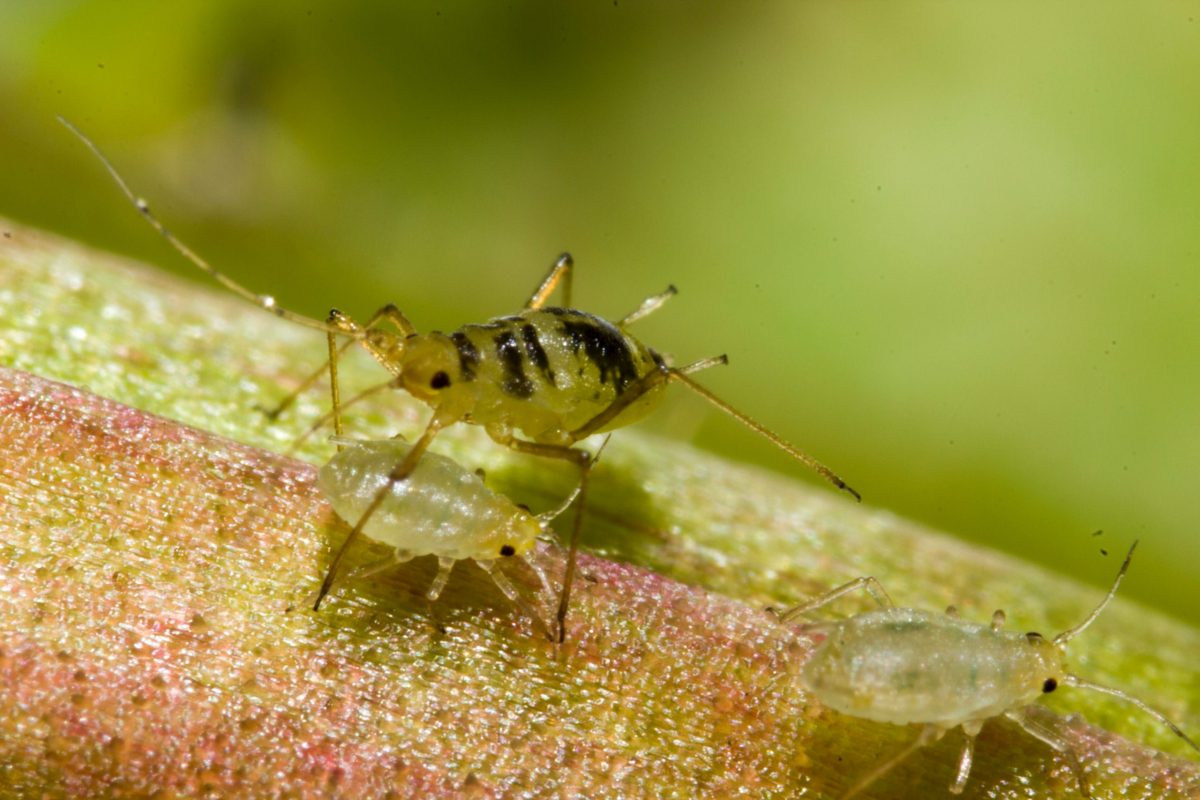Are you looking to learn more about aphids on tomato leaves so that you can finally get rid of them? This post explains 10 things you need to know about aphids so that you can better deal with them.

Tomatoes make a great sauce, don’t they?
When you are not using them to add substance to your cooked meals, you are tossing slices of tomatoes onto a quick salad.
Yum, absolutely delicious!
As a lover of tomatoes, you have been trying hard to cultivate them. Your tomato yield is usually good, but if only those voracious and copious aphids on tomatoes in your garden would go away.
If only they would give your succulent tomatoes some room to breathe and thrive.
They can, but not without a bit of effort on your part. You can use organic means to get rid of aphids on your tomatoes, or any other plant for that matter. If you haven’t seen the article on organic aphid control, head on over after reading this one.
If you have been spotting aphids on tomatoes in your garden, these are 10 things to consider so that you can get your defenses up.
Aphids on Tomatoes: 10 Things to Know
Are you ready to learn about the nature of aphids to ensure you are armed to deal with them? Let us jump to the first tip.
1. Replenish Your Tomatoes
Boost your tomatoes. When you spot aphids on tomatoes in low numbers, they are less likely to cause harm to your crops. Ensure your tomato crops are healthy, and do not panic if you see aphids crawling back and forth.
These tend to go away quickly as they are often targeted by beneficial insects. Quite often, tomato plants can take a beating from aphids without suffering much in terms of crop loss. But, as with everything, you must weigh the level of infestation to make such a judegment call.
For organic ways to strengthen your tomatoes, here are a few fertilizers that are worth trying.
2. Beneficial Insects Can Get Rid of Aphids on Tomatoes
Beneficial insects can provide relief for your tomatoes. These predatory insects prey on aphids for their meal. Other beneficial insects lodge their eggs in aphids to continue their reproductive cycle, which later kills them.
Predators of aphids include lacewing larvae and ladybeetles. Aphids are parasitized by parasitic wasps.
3. You Will Not Always Need Chemicals
While chemical control is not normally required with an infestation of aphids on tomatoes, it is warranted when up to 50% of leaves are teeming with these pests.
As the potato aphid shows the least resistance to chemicals, they are easier to contain. There are various aphid sprays available on the market, so if you are not averse to using chemicals, consider the options below. (Note: some of these options are natural and organic)
- BioAdvanced Fruit, Citrus & Vegetable Insect Control
- AgroMagen, GrowSafe Bio-Pesticide
- Yellow Sticky Aphid Whitefly Trap
- Ortho Tree & Shrub Fruit Tree Spray
- BonideReady-to-Use Insect Soap
Do you prefer to go completely organic when dealing with aphids on tomato leaves? Don’t forget to check out this post.
4. Aphids Can Stunt Plant Growth
If aphids on tomatoes in your garden are outstanding (in chunks and clusters) they can prevent your crops from thriving. If left untreated, they can stunt and twist leaf growth.
With little to no leaf coverage, tomato fruits can be left bare, at the mercy of the scorching sun. With their tiny mouthparts, these soft-bodied insects will suck sap from your tomato plant.
5. Aphids are Vectors of Plant Diseases
Aphids are carriers of plant viruses. This can happen in seconds if vector-carrying insects feed on your tomato plants.
If you are aware of a tomato virus in the area that is on the sprout, try to curtail an aphid infestation rapidly. This will prevent the possibility of your tomatoes becoming infected, should vector-carrying aphids begin feeding on them.
To prevent your tomatoes from becoming infected/affected by aphid vectors, here are a few products to control plant disease within your garden.
- Ortho Insect Mite & Disease 3-in-1 Ready-To-Use
- BIOADVANCED 701287A 3-in-1 Insect, Disease, and Mite Control for Plants
- AgroMagen, GrowSafe Bio-Pesticide, Organic Natural Miticide, Fungicide and Insecticide, Non-Toxic, Concentrate
6. Check Seedlings Before Transplanting
Do not transplant tomato seedlings infested with aphids. Seedlings are especially vulnerable when transplanted, so ensure to get rid of aphids on tomatoes in your garden before uprooting. The next step is to allow the plant time to recuperate, especially if the infestation was horrible.
7. Different Types of Aphids Target Tomato Plants
Potato aphids (Macrosiphum euphorbiae) tend to migrate to colonize tomato fields in early spring. These aphids are often winged, but it is not uncommon for wingless aphids to infest your crops.
The two most common species to plague your tomatoes include the green peach aphid (Myzus persicae) and the potato aphid. The size of both species is about 1/8 inch, but they often differ in color.
Want to learn about an organic way to repel and kill aphids in your garden? Learn how to make your own DIY garlic aphid spray.
Potato aphids resemble the shape of an avocado. These wear a solid pink, smears —or spots— of pink, or green color. Some potato aphids boast a light green hue with a distinct dark stripe. In addition to their color, they have two extended, lean tail-like, projecting tubes (cornicles).
Much like potato aphids on tomatoes, green peach aphids are pear-shaped. They wear with pride a light yellow to green color. They will, at times, appear with orange or pink coating. Cornicles of the green peach aphid are shorter in comparison to other aphid species.
8. Lookout for Honeydew
A sticky substance on your tomato plants could indicate the presence of aphids. This is because aphids make honeydew, which is coveted by ants and other insects.
A queue of ants is also an indication that you have aphids. By the way, if you want to learn more about the strange, mutually beneficial chemistry between ants and aphids, check out this article.
9. Look Out for Sooty Mold
Once aphids start feeding, they will secrete honeydew. Honeydew on your tomatoes promote black sooty mold growth.
While this fungi growth is mainly a cosmetic concern for gardeners, it can interrupt the process by which your tomato plants make food (photosynthesis).
10. Smother Aphids to Death
To control aphids on tomatoes in your garden, combine 3 tablespoons of liquid soap (castile soap can be used as it is vegetable-based) with 4 liters of water. Use this solution to spray your tomatoes every week and monitor the situation.
Always cover aphids on tomatoes with the spray solution used. Otherwise, this treatment will not be effective. The undersides of tomato leaves should be sprayed. Learn more about killing aphids with soapy water here.
Share the Love
If you’ve enjoyed reading about tips you can follow when you spot aphids on tomatoes in your garden and found it beneficial to your situation, don’t forget to share.
Sharing our content with friends and family helps to keep the lights going so that we can continue to help you deal with simple and serious pest problems at home. As usual, we welcome any questions you may have. Please make use of the comments section below






